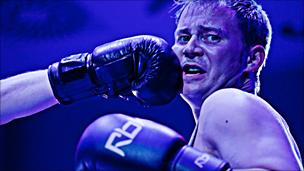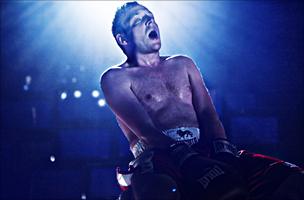Ringside seats at the theatre
- Published

The play tells the story of five young Scottish boxers
The late, great US sports commentator Howard Cosell said in his controversial 1985 autobiography I Never Played the Game: "Boxing is drama on its grandest scale".
Beautiful Burnout, a new National Theatre of Scotland play, takes that statement to its natural conclusion when its run of London performances is staged at York Hall in east London.
The boxing gym, which dates back to Victorian times, has played host to British gladiatorial legends like Chris Eubank, Ricky Hatton and current WBA World Heavyweight Champion David Haye.
It is the first time the gym has invited a theatrical production into its main arena.
The new play focuses on the fledgling pugilistic careers of five young boxers and their grizzled trainer and is told on a square platform, almost the exact dimensions of a professional boxing ring.
The audience is seated on three sides of the makeshift ring.
"The main thing was to have the audience have the experience of watching the action in a similar way to an actual boxing match," says director Scott Graham.
"It's not an actual ring, it doesn't have ropes. We didn't want to have ropes because they kind of keep the violence in - it makes it a safer place. We wanted an open environment where this violence could spill out.
"It's more exciting for the audience."

The actors all trained at gyms prior to rehearsals
The play, a collaboration between the NTS and the award-winning physical theatre company Frantic Assembly, launched at the Edinburgh Fringe to some acclaim.
A four-star review in The Guardian , externalpraised the "brilliantly acted exploration of what makes boxers box and what happens when a shooting star shimmers, shines brightly and falls to earth".
Particular praise has been lavished upon the actors, who push themselves to the limits of physical endurance on a nightly basis as they act out training scenes and choreographed bouts.
Graham says: "The boxing scenes feel very real and that's been our aim all along - it has to have that authenticity otherwise it just falls apart.
"We found in casting the show, when you get someone standing in front of you and you think, 'Yeah, you look like a boxer,' but you get them to put their fists up and get into a boxing stance, you know right away they're not."
Graham insists he wants both fans and critics of the sport to see the play. Attracting the former should not be too difficult but the latter audience may prove trickier.
There is no doubt that boxing audiences have been on the decline for the past two decades.
This is due, in part, to the lack of boxing matches on terrestrial television.
Former Olympic champion Audley Harrison had more than a dozen fights broadcast on the BBC following his gold medal in Sydney in 2000, but the sport is now almost entirely consigned to satellite and cable channels.
The onset of pay-per-view has proved an expensive barrier for fans from boxing traditional working class roots.

Boxing audiences have declined in recent years
But opinion has undoubtedly been swayed by the sheer brutality of a sport where the object is to beat another athlete into submission.
In 1991, British boxer Michael Watson nearly died after sustaining a serious brain injury during a particularly brutal title bout against fellow Brit Chris Eubank. And as early as 1982, the British Medical Association called for a complete ban on the sport.
A study in the New Scientist in 2007 found that even in the case of amateur boxing, the use of protective headgear does little to protect the fighter from damage to the brain.
"What attracted us to it was certainly the physicality of the sport but also just how much people put into something that can be utterly repellent to others. And how people wilfully place themselves in danger when others might run from that scenario."
He continues: "There are massively opposing reactions to boxing. The fight is gladiatorial, of course, but for us it was the process up to the fight. It's the world that's created in the gym, we found this place to be amazing."
Beautiful Burnout is the second play of 2010 to address matters inside the ring, the other being Roy Williams's acclaimed Sucker Punch at the Royal Court - told against the backdrop of the Brixton race riots in the early eighties.
Graham points out that the two works, while similar visually, have different dramatic aims.
"Our show is about the boxing, we found the boxing to be utterly compelling, where something like Sucker Punch used boxing as a vehicle for racial tension, which I believe it did very well."
The play is also the latest in a line of recent productions to move out of the theatres and utilise different spaces.
In London, this has meant works being staged in disused tunnels, railways arches and even car parks.
But Graham says a move outside the buildings doesn't necessarily bring down production costs in a time when arts funding faces swingeing cuts.
"I think it's more for artistic reasons rather than financial. I don't know if it will ever make economic sense taking theatre works out of theatres."
But, he adds, "the cuts are terrifying, especially for the touring circuit because you have every venue, they have all these companies knocking on their door for a slot.
"But if the theatre loses some of its funding and has to cut its shows from six to four, then competition increases."
Beautiful Burnout is on at York Hall in London until 2 October.
- Published7 June 2010